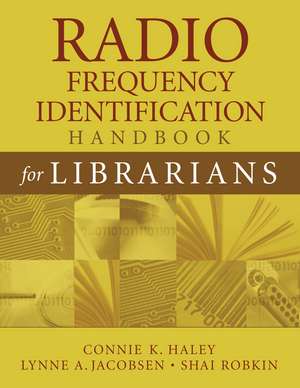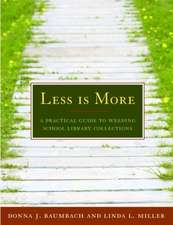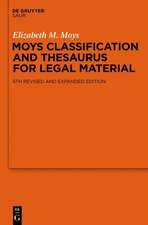Radio Frequency Identification Handbook for Librarians
Autor Connie K. Haley, Lynne A. Jacobsen, Shai S. Robkinen Limba Engleză Paperback – 29 mar 2007 – vârsta până la 17 ani
Preț: 257.76 lei
Preț vechi: 331.33 lei
-22% Nou
Puncte Express: 387
Preț estimativ în valută:
49.33€ • 51.31$ • 40.72£
49.33€ • 51.31$ • 40.72£
Carte tipărită la comandă
Livrare economică 14-28 aprilie
Preluare comenzi: 021 569.72.76
Specificații
ISBN-13: 9781591583714
ISBN-10: 1591583713
Pagini: 176
Dimensiuni: 178 x 254 x 11 mm
Greutate: 0.38 kg
Ediția:New.
Editura: Bloomsbury Publishing
Colecția Libraries Unlimited
Locul publicării:New York, United States
ISBN-10: 1591583713
Pagini: 176
Dimensiuni: 178 x 254 x 11 mm
Greutate: 0.38 kg
Ediția:New.
Editura: Bloomsbury Publishing
Colecția Libraries Unlimited
Locul publicării:New York, United States
Notă biografică
Connie Haley is Director for Information Systems and Technical Services at Chicago State University. She is an educator and librarian with 30 years experience in education, library, and information technology. Her experience includes teaching, management information systems, technical service and project management, such as the RFID conversion project. She has worked with Florida's Lee County Library Systems and Triton College in the Chicago area. Her research interests relate to library technologies, professional development, libraries in an online learning environment, and lifelong learning.Lynne A. Jacobsen is Director of Technical Services at the Warren-Newport Public Library in Gurnee, Illinois.Shai Robkin is President of Vernon Library Supplies.
Cuprins
AcknowledgmentsChapter 1: Introduction to RFIDChapter 2: Considering Implementation of RFIDChapter 3: Tags, Readers, and ApplicationsChapter 4: How to Select a VendorChapter 5: How to Manage the RFID Conversion ProjectAppendix A: Answers to Frequently Asked QuestionsAppendix B: Budget SheetAppendix C: Conversion Guidelines: A SampleAppendix D1: Survey Results of Library RFID ProductsAppendix D2: A Survey LetterAppendix E: On Tag Sorting FeaturesAppendix F: RFID ResourcesAppendix G: Using OpenRFP for RFID Vendor SelectionSuggested ReadingsIndex
Recenzii
The authors--two technical service librarians and a library vendor--introduce readers to RFID technology with an overview of implementation considerations including pros and cons. They also cover the RFID data model, privacy and security issues, the types of tags and readers available--including self-checkout and automated return/sorting systems--vendors, and managing a conversion project that uses existing barcode data. The appendixes include a Frequently Asked Questions section, a budget sheet, conversion guidelines, and a listing of RFID web resources. Overall, this book offers a thorough treatment of the subject and will be useful for libraries considering RFID.
Because of both the breadth and the depth of the information presented, this handbook could very nearly servce as a sole source for someone undertaking an RFID project. It covers all aspects of the technology and is very thorough in answering nearly every conceivable question a librarian might have when considering conversion to an RFID system. This guide is well-written and informative, and highly recommended for academic and public librarians interested in learning the basics of RFID or wishing to implement a system of their own.
The issue of whether and how to implement RFID in libraries is timely and pertinent to space planning as well as technology planning..This handbook is clearly written and makes techincal information easily understandable. The liberal use of lists, photographs, charts, and diagrams adds value for communicating with and training project teams. The author successfully present a professional tone that makes the information clear for any type of library and does not show bias for particular vendors..I highly recommend this handbook for any librarian who may participate in an RFID decision or implementation project.
This book provides some good hints and tips and gives a useful summary of this technology. As part of preliminary background reading this book provides some very useful technical information.
Haley, a system librarian at Chicago State University Library, provides background on the technology and benefits of radio frequency identification (RFID) technology in this guide for academic and public librarians wishing to convert to RFID technology. After a brief overview of how RFID technology works and its use in the retail environment, the guide discusses technical implementation issues for libraries as well as political and social concerns, costs, and physical logistics. Types of tags and readers are described, and there is advice on selecting a vendor. A final chapter outlines steps for managing the RFID conversion project. Appendices offer FAQs, sample budgets and conversion guidelines, and lists of web sites for RFID manufacturers, organizations, and news.
Radio Frequency Identification Handbook for Librarians is perfect for librarians wishing to convert to RFID technology.
This practical, clearly written guide will be helpful for librarians who are considering RFID systems for their institutions.
Because of both the breadth and the depth of the information presented, this handbook could very nearly servce as a sole source for someone undertaking an RFID project. It covers all aspects of the technology and is very thorough in answering nearly every conceivable question a librarian might have when considering conversion to an RFID system. This guide is well-written and informative, and highly recommended for academic and public librarians interested in learning the basics of RFID or wishing to implement a system of their own.
The issue of whether and how to implement RFID in libraries is timely and pertinent to space planning as well as technology planning..This handbook is clearly written and makes techincal information easily understandable. The liberal use of lists, photographs, charts, and diagrams adds value for communicating with and training project teams. The author successfully present a professional tone that makes the information clear for any type of library and does not show bias for particular vendors..I highly recommend this handbook for any librarian who may participate in an RFID decision or implementation project.
This book provides some good hints and tips and gives a useful summary of this technology. As part of preliminary background reading this book provides some very useful technical information.
Haley, a system librarian at Chicago State University Library, provides background on the technology and benefits of radio frequency identification (RFID) technology in this guide for academic and public librarians wishing to convert to RFID technology. After a brief overview of how RFID technology works and its use in the retail environment, the guide discusses technical implementation issues for libraries as well as political and social concerns, costs, and physical logistics. Types of tags and readers are described, and there is advice on selecting a vendor. A final chapter outlines steps for managing the RFID conversion project. Appendices offer FAQs, sample budgets and conversion guidelines, and lists of web sites for RFID manufacturers, organizations, and news.
Radio Frequency Identification Handbook for Librarians is perfect for librarians wishing to convert to RFID technology.
This practical, clearly written guide will be helpful for librarians who are considering RFID systems for their institutions.








